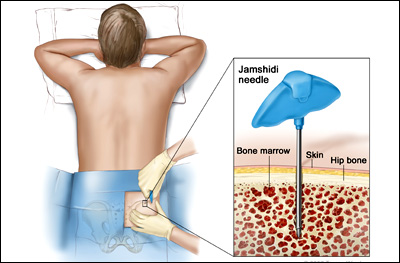|
What is Bone Marrow?
The soft material in the center of bones is the bone marrow. The bone marrow contains the different types of cells that give rise to red cells, white cells and platelets found in our blood.The marrow may also contain abnormal cells, proteins, or inflammatory processed that are not normally present, such as cancer cells. Since the production of red cells requires iron, the marrow is one of the places in the body that normally stores a supply of iron. When we are younger, our bone marrowcontains very little fat. As we age, the percentage of fat in our marrow increases.
What is a bone marrow procedure?
A bone marrow procedure (commonly referred to as a bone marrow or bone marrow aspiration with or without biopsy) is a technique used to obtain the blood-forming portion (marrow) of the inner core of bone for examination in the laboratory or for transplantation.
The bone marrow consists of inserting a special needle into a bone and withdrawing the
marrow by suction or coring out a sample of the marrow.

How is a bone marrow performed?
Typically, only a local anesthetic is required to numb the skin and tissue down to the surface of the bone. A small cut (less than one-quarter inch) is then made in the skin. A hollow needle whose center is filled by a removable metal rod called a trochar is used to penetrate through the dense outer shell of bone. Once inside the bone, the trochar is removed and a syringe is attached to the now hollow tube of the bone marrow needle. The bone marrow is withdrawn as a thick liquid by pulling back on the plunger of the syringe and collecting the liquid. This sample is known as the marrow aspirate. This part of the procedure only lasts a few seconds, but is usually the most painful due to the sudden sense of a negative pressure inside the bone.
A biopsy can also then be obtained in addition to the marrow aspirate or when an aspirate cannot be obtained. The same needle is used but without the center portion in place. As the needle is partially rotated into the bone it cuts a core which is trapped inside the needle. Once the needle is removed, this core can be extracted from the needle barrel. This core can then be prepared with fixatives and stains for examination under a microscope.
Since the skin cut for a bone marrow procedure is usually very small, no stitches are generally necessary and only a bandage is applied.
What diseases are diagnosed by bone marrow examination?
A wide variety of conditions can be diagnosed by examination of the bone marrow. The following examples illustrate some of the most frequent conditions, but there are many more. The presence or absence of cancer in the bone marrow can determine what treatments are recommended to a patient with cancer known to be elsewhere in the body. Some cancers (leukemia, multiple myeloma) arise from cells in the marrow so this is where the biopsy must be taken to confirm the diagnosis. A low blood-clotting element (platelet count) in the blood (thrombocytopenia) can be due to several causes. It is important to establish whether or not the cells that make the platelets (megakaryocytes) are still present in the marrow (idiopathic thrombocytopenic purpura [ITP]) or are gone (along with most other bone marrow cells as in aplastic anemia). Most cases of anemia (low red blood cells) can be diagnosed by simple blood tests. When these tests are negative, examining the marrow can reveal problems with the red blood cells that are uncommon causes of anemia (sideroblastic anemia, aplastic anemia). Persistent fevers can be caused by infections that reside in the marrow (atypical mycobacteria, brucellosis) and a sample of the marrow may provide the best source of culture material.
What are the risks of a bone marrow procedure?
Different individuals feel the pain caused by injection of the local anesthetic and the remainder of the procedure to a variable extent. There may be dull soreness for a day or two. Significant complications are very unusual but can include bleeding and infection, and prolonged pain. This procedure is only done by experienced physicians using special bone marrow needles. Bone marrow biopsies are done almost exclusively from pelvic bones. It is unsafe to perform a bone marrow biopsy on the sternum, and special needle with a guard on it is used for sternal marrow aspirations.
Rare fatalities have been reported, usually during sternal marrows when the needle has penetrated the sternum and cut one of the arteries on the surface of the heart. |